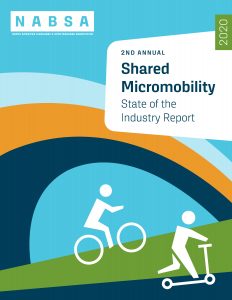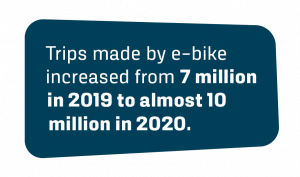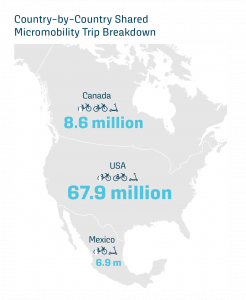NABSA’s 2020 Shared Micromobility Industry Report Features In-Depth Metrics and Highlights the Industry’s COVID-19 Resilience
Released on August 5, 2021 | Media Contact: Destinie Hammond - destinie@nabsa.net - 504.298.9269
 Today, we are pleased to present the second annual Shared Micromobility State of the Industry Report for North America!
Today, we are pleased to present the second annual Shared Micromobility State of the Industry Report for North America!
Due to the COVID-19 pandemic, 2020 was a challenging year for all sectors of transportation, and shared micromobility was no exception. The report quantifies the impact of the COVID-19 pandemic on shared micromobility and demonstrates the industry’s response and resilience during this time to provide essential mobility services. For example, despite a decrease in ridership in 2020, approximately 50% of shared micromobility systems reported an increase in first-time riders. By the end of 2020, ridership was within 20% of the previous year’s levels, rebounding more quickly than other shared modes.
“2020 was a challenging year for all, however, the COVID-19 pandemic highlighted the importance and resilience of shared micromobility as a transportation option for communities,” says Samantha Herr, NABSA Executive Director. “The report makes clear what we already knew – shared micromobility is an essential component of public transportation ecosystems and will continue to be embraced and grow.”
Around the world, diversity, equity, and inclusion received increased attention in 2020. The 2020 report demonstrates how the shared micromobility industry is taking steps to make organizational changes. This includes redeveloping hiring practices, resulting in 71% of shared micromobility operators saying that they include diversity as part of every hiring conversation. This focus on making impactful change also extended past the workplace as operators supported their communities during racial justice demonstrations by maintaining service and providing discounted fares for participants.
 The release of the second annual report allows us to compare in-depth year-over-year metrics demonstrating industry trends, growth, and success across North America. When compared to 2019, the popularity of e-bikes expanded resulting in 9.9 million trips taken in 2020, up nearly 3 million from 2019. Additionally, the number of available e-bikes increased from 12,000 to 23,000. This brought the total number of shared micromobility vehicles in North America to 169,000. The shared micromobility industry in North America resulted in the creation of an estimated 5,000 jobs, which is about 1 job for every 30 vehicles.
The release of the second annual report allows us to compare in-depth year-over-year metrics demonstrating industry trends, growth, and success across North America. When compared to 2019, the popularity of e-bikes expanded resulting in 9.9 million trips taken in 2020, up nearly 3 million from 2019. Additionally, the number of available e-bikes increased from 12,000 to 23,000. This brought the total number of shared micromobility vehicles in North America to 169,000. The shared micromobility industry in North America resulted in the creation of an estimated 5,000 jobs, which is about 1 job for every 30 vehicles.
“Shared micromobility remains an essential component of urban mobility that enables a clean energy transition,” says Lina Fedirko of the ClimateWorks Foundation, which supported the report. “The State of the Industry Report demonstrates key climate, equity, and community benefits that shared micromobility delivers to cities and their transportation ecosystems.”
 Shared micromobility continues to offer significant individual and community benefits. In 2020, we found that shared micromobility trips resulted in a reduction of 29 million pounds of CO₂ emissions and 12.2 million additional hours of physical activity by replacing car trips. The 2020 report also includes, for the first time, economic impacts. A recent study found that e-scooter programs increased unplanned spending at quick service restaurants and food and beverage stores. The study concluded that there was $921 of additional spending per scooter in the 6-month study period.
Shared micromobility continues to offer significant individual and community benefits. In 2020, we found that shared micromobility trips resulted in a reduction of 29 million pounds of CO₂ emissions and 12.2 million additional hours of physical activity by replacing car trips. The 2020 report also includes, for the first time, economic impacts. A recent study found that e-scooter programs increased unplanned spending at quick service restaurants and food and beverage stores. The study concluded that there was $921 of additional spending per scooter in the 6-month study period.
The report also shows the increased adoption of the General Bikeshare Feed Specification (GBFS), a data specification that enables travelers to find shared micromobility devices through trip-planning apps and integration with other public transportation services. The 2020 report found that the number of cities requiring GBFS increased from 56% to 69%.
In addition to the metrics reported in the 2019 report, the 2020 report added the following new analyses:
- Workforce diversity initiatives
- A country-by-country breakdown of ridership
- A country-by-country breakdown of vehicle types
- Cost considerations for private operators
- Enhanced public transportation metrics including proximity to transit, transit-related trip-making, and connection to transit
NABSA worked with Toole Design and the University of California Berkeley Transportation Sustainability Research Center to help develop the report. The report is composed of survey results, statistics gathered from performance reports released by shared micromobility systems, and data from GBFS.
The report is available for download at nabsa.net/industry.
